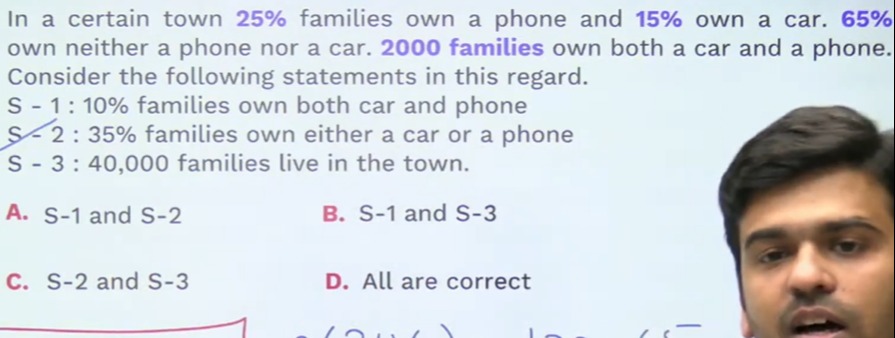Question
Question: In a certain town 25% families own a phone and 15% own a car. 65% own neither a phone nor a car. 200...
In a certain town 25% families own a phone and 15% own a car. 65% own neither a phone nor a car. 2000 families own both a car and a phone. Consider the following statements in this regard. S - 1 : 10% families own both car and phone S - 2 : 35% families own either a car or a phone S - 3 : 40,000 families live in the town.

S-1 and S-2
S-1 and S-3
S-2 and S-3
All are correct
S-2 and S-3
Solution
Let P be the event of owning a phone and C be the event of owning a car. We are given: P(P) = 0.25 P(C) = 0.15 P(neither P nor C) = P(P' ∩ C') = 0.65
Using De Morgan's law, P(P' ∩ C') = P((P ∪ C)'). So, P((P ∪ C)') = 0.65.
-
Calculate P(P ∪ C): P(P ∪ C) = 1 - P((P ∪ C)') = 1 - 0.65 = 0.35. This means 35% of families own either a car or a phone. Statement S-2 is correct.
-
Calculate P(P ∩ C): Using the Principle of Inclusion-Exclusion: P(P ∪ C) = P(P) + P(C) - P(P ∩ C) 0.35 = 0.25 + 0.15 - P(P ∩ C) 0.35 = 0.40 - P(P ∩ C) P(P ∩ C) = 0.40 - 0.35 = 0.05. This means 5% of families own both a car and a phone. Statement S-1 claims 10%, so it is incorrect.
-
Calculate the total number of families (N): We are given that 2000 families own both a car and a phone, which corresponds to 5% of the total families. 0.05 * N = 2000 N = 2000 / 0.05 = 2000 / (5/100) = 2000 * (100/5) = 2000 * 20 = 40,000. Statement S-3 is correct.
Therefore, statements S-2 and S-3 are correct.
